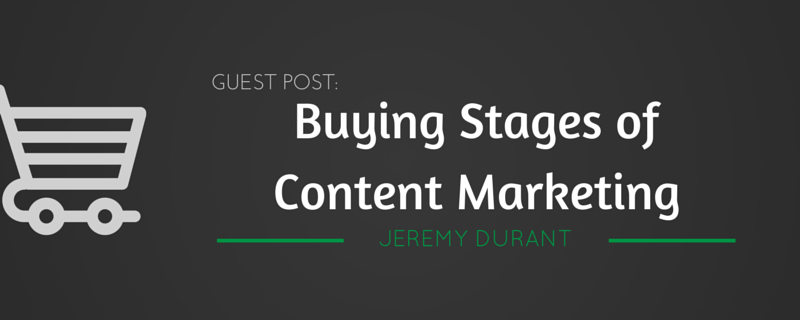BLOG
The 4 Buying Stages of Content Marketing

When it comes to lead generation, content marketing plays a big part in reaching, attracting, evaluating, and converting new business leads. When considering implementing a new B2C or B2B content marketing strategy, it’s important to start with an understanding of the 4 buying stages that make up the sales funnel. Understanding the buying stages helps to determine what your prospects are looking for and what content meets their needs.
The 4 Buying Stages Defined
The 4 stages of the buying process are discovery, consideration, decision, and measurement. During each of these stages, your prospect has a unique view of your company or services and is looking to consume a particular type of content. We’ll look at each of these stages more closely in the next section. The main takeaway here is that a variety of different content pieces, with different messages and functions, are essential to a successful content marketing strategy. The function of a content marketing strategy is to reach and guide a prospect down the sales funnel with carefully crafted content. Content must meet their needs and either disqualify them as a prospect or move them down the funnel. For many firms, a content marketing strategy has a long-term goal that is constantly loading the funnel with properly qualified and educated prospects.
Discovery of Content Marketing
The discovery phase of the sales process is really a qualification and initial learning stage. In this stage, you as the company are evaluating whether the prospect is a good fit for your client profile. Likewise, your prospect is qualifying whether your company provides the services or products they are looking to acquire.
In Discovery, content should establish your company as an expert. If a prospect doesn’t see your company as experts, this is an indication this partnership won’t work. In addition, the content marketing pieces should set the right expectations. By using content to set the expectations, you are building a foundation for a successful relationship, or you are disqualifying the prospect since your services won’t be a good fit for them.
Content that qualifies prospects includes things like budget estimates, timelines, decision makers involved, and a basic explanation of services. These pieces are all educational. Never be afraid to share pricing at this time since you want to evaluate the right fit for both you and your prospect. Your prospect may or may not have reached out to your competitors, so by giving the most information upfront, you arm them with the tools they need to evaluate your competitors. In the business-to-business space, this step is essential and builds your credibility with your prospect.
As a San Diego web design firm using content marketing, we’ve determined the best content for the discovery phase is a simple buying guide and educational blogs. The guide only needs to be a few pages and shares information like estimated cost, timelines, and services included. Prospects can use your guide as a benchmark for all your competitors throughout the sales funnel. Additionally, a few blogs aimed at educating potential prospects can go a long way to attract potential clients.
Content for Consideration
A prospect moves into the consideration phase when they start to invest more of their time and energy into understanding the solution your company offers. Typically, in this stage of the buying process, the person focuses less on rational content that is metric-related and responds best to emotion-based content. This is the stage of the cycle that focuses more on their individual situation and their particular pain points.
During the consideration phase of the sales cycle, content marketing efforts should center on how solutions address their particular pain points. It’s a great time to compare the status quo to the possibility of what could be with your solutions. Content should delve into the emotion behind the pain points, like frustration, anxiety, faith in the process, pleasure, etc. Content marketing that appeals to a prospect’s emotional side has the biggest effect at this point. For example, if the solution you are marketing saves prospects 30-40 hours a month, discuss how this can impact their lives. With 30-40 hours of extra time each month, they could finally take a vacation, reduce their time in the office, or spend more time focusing on their family. Even in B2B content marketing, it’s beneficial to create pieces that appeal to emotions.
When it comes to content that really appeals to emotions, Before-and-Afters are your best bet. Seeing the possibility of what can be plays to your prospects emotions and inspires them with possibilities. Additionally, Case Studies can also be effective in this particular stage. While case studies rely on metrics, they again show the benefit of your solutions and address pain points.
Decisions Are Easier with Content
The next phase of the sales funnel is the decision phase. At this point in the process, the prospect is now considered a potential client because they are making a serious choice and your firm is a top contender. The potential client’s needs shift back to practicalities like timelines, payment, deliverables. Many companies don’t understand that at this point, content marketing is still essential to the process. The content produced should be created with the view that the potential client is a new client.
For the decision phase, content marketing needs to build up your firm’s credibility and give them peace of mind. By creating trust, you assure the client your firm is the right choice and you know what you are doing. A sense of trust and faith in your processes enables a potential client to confidently select your firm over your competitors. All content produced at this point needs to be personalized to that specific client and should ease any concerns and address all questions.
It comes as a surprise to many people what is considered content marketing at this point. A customised project schedule, a service agreement, and payment terms are the best types of content pieces to create and share with a potential client in the decision phase. They are considered part of the content marketing process because they answer questions, provide information, and move the process through the funnel to a closed sale.
Measurement: Your Content Crescendo
The final stage we are discussing is measurement, which is where your firm can determine what content positively contributed to the buying process and what content needs to be refined or is missing. The measurement portion is really performed by your internal team and includes both Sales and Marketing. The Marketing portion measures content using web analytics and social media. The Sales part takes a closer look at leads generated and the length of the sales cycle. Evaluating and measuring content at this stage enables you to ensure you are getting the best usage out of your content efforts.
When measuring the efficacy of your content efforts for marketing, web analytics and social media are instrumental. Ideally, the majority of your content is digital and is hosted on your company’s website. As such, a resource like Google Analytics can help you set goals and track content engagement. To evaluate your content, take a look at things like time spent on site, pages per session, and the top viewed pages. Next, take a close look at what types of content is getting engagement on your social media channels. Engagement can be determined by looking at the number of shares, clicks, and comments. Finally, go back to your analytics to check your social engagement by looking at the referral traffic coming to your site from social networks.
The Sales measurement of your content marketing strategy should look at leads generated and the length of the sales cycle. Looking at the leads generated takes a broad view and requires compiling information across various channels. Using calls-to-action with clear tracking capabilities enables you to accurately track lead generation. For example, leads can be generated in the form of newsletter sign-ups, ebook downloads, or contact form completions. These types of activities should be added to Google Analytics for easy tracking and comparison. When it comes to the Sales cycle, clear communication with your Sales team is essential. Your Sales team will be able to tell you if a particular piece of content is attracting the wrong kind of prospect. They can also tell you what common questions they get from prospects, common misconceptions they must address, and how they explain your value proposition to prospects.
By regularly measuring your B2B content marketing strategy, you can update and change your strategy to be more effective and produce the best results. Trackable results shown over a reasonable time frame are the best measurement. Never take anecdotal bits of information as measurement.
An Effective Content Marketing Strategy Builds Leads
A content marketing strategy can have many goals: thought leadership, branding, awareness, audience-building, sales support, etc. However, all successful content marketing strategies build and generate leads. By carefully examining and creating content for each stage of the buying cycle, you can launch a content marketing strategy that generates high-quality inbound leads.
ABOUT THE AUTHOR

Jeremy Durant is Business Principal at Bop Design, a B2B web design and marketing company based in San Diego, CA. Jeremy has written countless blogs and given interviews discussing best practices for website development, branding, content marketing, logo design, social media, PPC, SEO, and internet marketing strategy.











